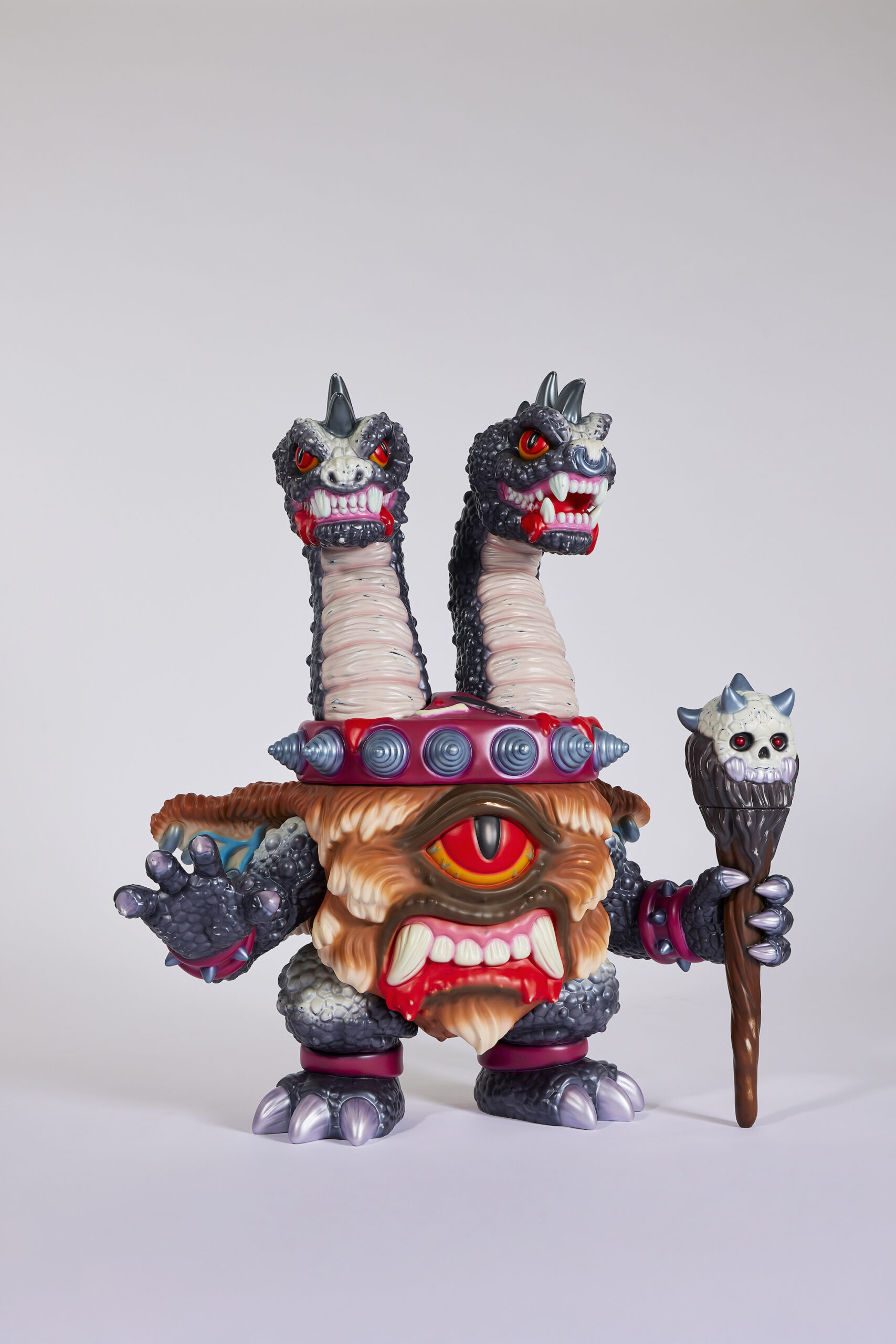
この度HENKYOでは、10/18(土)より 彫刻家、コムロタカヒロの2年ぶりとなる個展「The Hollow Ritual」を開催いたします。また本展では開催を記念し、コムロタカヒロによるソフトビニール製のエディション作品「Ground dragon #1」の抽選販売をいたします。
詳細はコチラ
祀るという形式の残響と像のエコー
本展《The Hollow Ritual》は、「祀る」という制度的行為の形骸化を前提としつつ、その形式だけが生き残ってしまった時代において、彫刻はなお像 をつくるに値するのか、という問いに応答するものである。祀るべき対象を喪失したにもかかわらず、像をつくり、棚に載せ、台座に据える──その矛盾のなかで、彫刻はいかなる倫理と情動を宿しうるのか。ここに展示されるのは、信仰の残骸ではなく、信仰の不在に抗おうとするかたちで生 まれた像の試みである。
信仰の二重の喪失と制作動機の根源
本展の基調には、二重の信仰の喪失がある。ひとつは、1945 年の敗戦によって日本社会が経験した国家的信仰、すなわち天皇を中心とする精神的・ 宗教的体系の崩壊である。それは宗教制度の単なる転換ではなく、祀る対象とその権威を同時に喪失した文化的断絶として発生した。もうひとつは、 作家個人の体験としての、家庭内で信仰されていた宗教の放棄である。この二重の喪失は、戦後日本の精神風景と作家のアイデンティティ再構築の プロセスとを重ね合わせ、像をつくるという行為を、精神の依代を自ら彫り出す営みへと変質させた。そのとき作家が手に取ったのは、信仰とは本 来無縁であるはずの使い古された玩具──ドラゴン、魔神、モンスターといったフィギュアたちである。それらは神ではない。しかし、** 祀ること が可能な「かたち」** を備えていた。この造形への執着と違和感の交錯こそが、本展における彫刻の形式と主題を根本から規定している。
魔神像:崇高なものの再構築としての怪物
木彫の《Mushussu》は、アメリカのホラーフィギュアやビデオゲームの RPG のラスボス、90 年代以降のヴィラン像などを出発点とする。双頭や翼、 鎧、牙といった記号によって構成されるそれらの像は、かつての神像が担っていた「崇高さ=The Sublime」を、恐怖や破壊といった現代的感情を通 して再構築する試みである。彫刻としての構成は、曲線と鋭角、過剰と秩序、重量感と玩具性といった相反する要素を交錯させており、“神像” とし ての制度的記号性と、マスプロダクト的なビジュアル言語とがせめぎ合う。そこには、ホラーと神話、信仰と商品が同一の造形圏内で交差するよう な構図が意図されている。魔神像は、信仰を喪失した時代=ポスト宗教的状況においてなお “神のかたち” を模索する情動が、いかなる造形的言語と 接続されうるかを、彫刻の物質性を通して問う存在である。
首像群:晒し、記念、消費のフォーマットを重ねる
一方、木彫の《Heads》シリーズは 16 体の頭部彫刻によって構成され、壁面に設置された格子状の棚に収められる。PEZ ヘッドやキャンディボック スなど、1980 年代のアメリカ製玩具に典型的な “頭部だけ” の造形を直接引用しながら、西洋彫刻における首像と、日本の中世における晒し首という、 形式的にも意味的にも対照的な二つの制度を重ね合わせている。各像は悪魔、魔女、ミイラなどホラー的なモチーフをまとい、人間の実寸大に近い サイズで制作されている。玩具的な親しみと不気味さが共存し、それが鑑賞者に「これは祀る像か、罰せられた像か」という問いを生じさせる。陳 列の秩序性と断片的な身体性は、偶像と断罪、祝祭と刑罰の両義性を浮かび上がらせる。「首」という身体部位に焦点を当てることは、記念彫刻に内 在する崇敬の形式と、暴力的断絶の構造とを同時に喚起する。首だけの像を棚に祀るという行為は、制度の残骸を用いて、かつてあった精神の中心 を模索する儀礼の模倣として機能する。
ソフビ像:可塑性の祭壇と流通する依代 展示の第三の構成要素は、ソフビ製のドラゴン像を壁付けの棚状の祭壇に設置するインスタレーションである。ここで祭壇は、もはや宗教的空間で はなく、消費社会における私的な崇拝の装置=コレクションケースとして再定義される。本来子供の玩具として生まれたソフビは、現代においてはアー トトイとして再評価され、コレクターによって神棚のように並べられ、飾られ、祀られる。作家はこれまで、玩具を彫刻に昇華し、祀るという形式 を逆説的に実践してきたが、ここでは逆に、彫刻の形式を玩具へと還元し、依代として流通させるという反転を試みている。この作品において、ソ フビは彫刻であると同時に、「祈りの制度なき時代」における ** 可塑的で移動可能な依代(よすが)** となる。量産され、消費されることで祀られ る像──それはポスト宗教時代における新しい信仰の形式である。
彫刻はいまなお、祀ることができるのか? 本展が提起する問いは、「像をつくる」という行為の根源的な意味である。それは、祀るべき対象が失われ、象徴的秩序が解体されたあとにおいて、 なおも彫刻が成し得る倫理とは何か、という問いである。玩具は本来、消費され、廃棄されるための存在である。しかし、そのなかに「祀れる形」が宿っ ていると仮定することで、消費文化の中に埋もれた信仰の残響が彫刻として再浮上する可能性が開かれる。ここにある像たちは、信仰の代理ではない。 信仰の不在そのものに、像としてかたちを与える行為の痕跡である。祀るべきものはすでに存在しない。 それでも、祀るという形式をやめることができない人間の手が、像を彫り続けている。《The Hollow Ritual》は、象徴の消失以後における「像の宿命」 と、それに抗い続ける彫刻の倫理への一つの応答である。
コムロタカヒロ
1985年生まれ。東京を拠点とする彫刻家。1980~90年代の玩具文化や日本的信仰観に影響を受け、主に木彫とソフビを媒体に独自の彫刻世界を展開している。彫刻を「祀ること」として捉え直す批評的視点をもち、現代における信仰や制度の空洞化を主題に制作を行う。
|
HENKYO is pleased to present “The Hollow Ritual” the solo exhibition in two years by sculptor Takahiro Komuro. This exhibition will feature 17 new wooden sculptures alongside soft vinyl edition pieces (available via lottery).
Echoes of the Ritual and the Afterlife of the Idol
The Hollow Ritual addresses a central question: in an age where the institutional act of enshrinement has collapsed, and only its forms remain, can sculpture still justify the making of idols? When the object of devotion has vanished, yet figures are carved, placed on pedestals, and set into shelves, what ethics or affect remains in the act of sculpting? This exhibition presents not relics of belief, but sculptures born from resistance to the absence of faith itself. Dual Loss of Belief and the Origins of Practice At the core of this exhibition lies a dual rupture of belief. The first is historical: the collapse of state-centered faith in postwar Japan following its 1945 defeat̶the symbolic death of a spiritual system centered on the emperor. This was not merely a change in religious institutions, but a cultural rupture marked by the sudden loss of both the object of worship and its authority.
The second rupture is personal: the artist’ s own renunciation of the religion practiced in his childhood home. Together, these two losses shape the psychological landscape of postwar Japan and underpin the artist’ s drive to carve figures̶transforming the act of sculpting into one of producing spiritual substitutes.
The artist turned to objects not traditionally associated with faith: worn-out toys such as dragons, demons, and monsters. These were not gods̶but they possessed forms that could be enshrined. This tension between fascination and alienation lies at the heart of the sculptural logic and thematic structure of the exhibition.
Demon Icon: The Monster as a Reconstruction of the Sublime
The carved wooden sculpture Mushussu draws inspiration from American horror figures, RPG video game bosses, and post-1990s visual villain archetypes. Constructed from symbols like double heads, wings, armor, and fangs, these sculptures attempt to reconstruct a sense of the sublime through fear, destruction, and hybridized grotesquery.
Formally, they intersect curvilinear and angular geometry, excess and restraint, heaviness and toy-like plasticity. Institutional iconography meets mass-produced visual language, creating a sculptural system where horror, mythology, faith, and commodity co-exist.
The demon icon, in this context, does not recover the sacred̶it instead stages a desire to recover the shape of the sacred in an era defined by its loss. In this post-religious moment, the monster emerges not as antagonist but as surrogate.
Heads: Between Display, Memorial, and Punishment
The Heads series consists of 16 wooden busts, displayed in a grid-like wall shelf reminiscent of shrines or storage units. Referencing PEZ dispensers, candy boxes, and other head-only toy designs from 1980s America, the works juxtapose Western busts with medieval Japanese severed head displays (sarashikubi)̶two systems of visualizing authority and mortality.
Each head features horror motifs̶demons, witches, mummies̶carved at nearly life-size scale. Their combination of playfulness and unease prompts the viewer to wonder: are these figures revered or condemned? The rigid shelving system evokes the duality of idol and execution, celebration and punishment.
Focusing on the severed “head” emphasizes both commemorative and violent symbolic structures. Placing these heads on a shelf becomes a mock ritual, seeking a lost spiritual center through the ruins of past systems.
Soft Vinyl Dragon: Portable Altars and Circulating Vessels
The third component of the exhibition is a wall-mounted altar housing a soft vinyl dragon figure. Here, the altar is no longer a sacred site but a reinterpretation of the collector’ s display case̶a private shrine in the age of commodity fetishism.
Originally designed as children’ s toys, soft vinyl figures (sofubi) have been recontextualized as art objects, lovingly displayed and elevated in collectors’ homes. In contrast to his prior works where toys were enlarged and reinterpreted as sculpture, the artist now reverses the logic: he miniaturizes sculpture, allowing it to circulate as a portable vessel for faith in a post-religious world.
The sofubi figure becomes both artwork and idol proxy̶mass-produced, circulated, and enshrined. This inversion proposes a new mode of belief: one that does not depend on fixed institutions, but instead on form, handling, and repetition.
Can Sculpture Still Enshrine?
What is at stake here is the fundamental question of making images. In a time where symbolic orders have dissolved and objects of reverence have faded, what remains for sculpture to hold onto?
Toys are meant to be consumed and discarded. But within them lies a form that could be enshrined. This exhibition proposes that remnants of belief still linger in these forms̶that sculpture can give shape not to gods, but to their absence.
These figures do not represent religion. They are the traces of belief as it disappears.
Even in the absence of gods, the human hand continues to carve.
The Hollow Ritual is a sculptural response to that compulsion̶to the fate of the image in the aftermath of meaning.
Takahiro Komuro (b. 1985) is a sculptor based in Tokyo. Influenced by 1980s–90s toy culture and Japanese modes of spirituality, he develops a unique sculptural world using primarily woodcarving and soft vinyl as his mediums. His practice critically reinterprets sculpture as an act of enshrinement, exploring the theme of spiritual and institutional hollowing in contemporary society.
|
